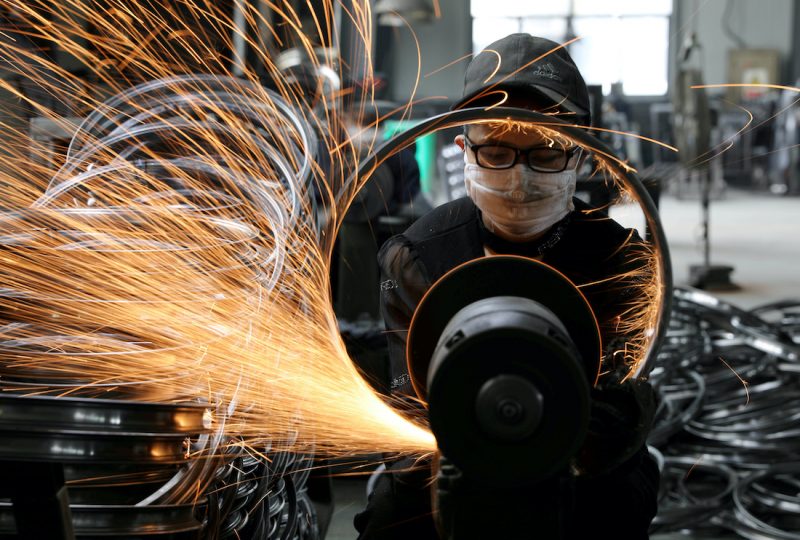Factory output weakened in many of Asia’s biggest economies in September as demand slows in China and advanced economies added to the pain with rate hikes to contain inflation.
Manufacturing activity shrank in Taiwan and Malaysia, and grew at a slower pace in India, Japan and Vietnam compared with August, surveys showed on Monday.
Rising raw material costs and the darkening global outlook weighed on corporate sentiment, clouding the region’s economic recovery prospects.
The surveys came after China‘s factory and services activity data on Friday pointed to further cooling in the world’s second-largest economy as strict Covid lockdowns disrupted production and dampened sales.
“We’re seeing economic conditions deteriorate in China, the United States and Europe. That’s definitely weighing on Asian manufacturing activity,” Toru Nishihama, chief economist at Dai-ichi Life Research Institute in Tokyo, said.
“While supply disruptions may have run its course, Asia is now suffering from slumping global demand.”
ALSO SEE:
US Sanctions Indian, UAE, China Firms for Iran Oil Deals
Manufacturing Slips in North, Southeast Asia
The au Jibun Bank Japan Manufacturing Purchasing Managers’ Index (PMI) slumped to 50.8 in September from 51.5 in the prior month, marking the weakest growth rate since January last year.
New orders shrank at the fastest rate in two years, while output posted its sharpest decline in a year due to weakening demand from China and other trading partners, Japan’s PMI survey showed.
“Weakness in the yen is doing little to bolster export demand either and instead is pushing imported inflation up drastically and drove domestic price pressures up even further,” said Joe Hayes, senior economist at S&P Global Market Intelligence.
Taiwan’s PMI hit 42.2 in September, down from 42.7 in August and staying below the 50 mark that separates growth from contraction on a monthly basis.
Vietnam’s PMI fell to 52.5 from 52.7 in August, while that of Malaysia slid to 49.1 from 50.3, the surveys showed.
Indian Factory Growth Cools
India’s factory growth dipped to a three-month low in September due to a moderation in demand and output, despite easing inflationary pressures and strong business confidence, a private survey showed.
The Manufacturing Purchasing Managers’ Index, compiled by S&P Global, fell to 55.1 in September from 56.2 in August, below the 55.8 predicted by economists in a Reuters poll. The pace of growth was still solid, however, and was above the 50-mark separating growth from contraction for a 15th straight month.
“The Indian manufacturing industry remains in good shape, despite considerable global headwinds and recession fears elsewhere,” said Pollyanna De Lima, economics associate director at S&P Global Market Intelligence.
“There were softer, but substantial, increases in new orders and production in September, with some leading indicators suggesting that output looks set to expand further at least in the short-term.”
Input costs rose at the slowest pace since October 2020 and most firms reported no change in purchasing prices.
But a separate Reuters poll showed inflation wouldn’t fall to within the Reserve Bank of India’s (RBI) target band of 2-6% until the first quarter next year. Consumer price inflation accelerated to 7% in August, driven by a surge in food prices and snapping a three-month downward trend.
Optimism about future output was at the highest level in seven and a half years and international demand was the strongest since May, led by robust external demand for goods amid a weak Indian rupee.
“Currency risks and the impact of a weaker rupee on inflation and interest rates could derail optimism during October,” added De Lima.
Rate Hikes Also Cool Manfacturing in Europe
Manufacturing activity across the euro zone also declined further last month as a growing cost of living kept consumers wary while soaring energy bills limited production.
S&P Global’s final manufacturing Purchasing Managers’ Index (PMI) for the bloc fell to a 27-month low of 48.4 in September from August’s 49.6.
“The European manufacturing sector continues to face serious challenges, weighed down by surging energy prices, while new orders are seeing further decline,” Thomas Rinn, global industrial lead at Accenture, said.
“Economies continue to face drawbacks from high inflation, growing uncertainties and the increasing cost-of-living crisis.”
Soaring energy costs set off alarm bells about the outlook for business in Germany, Europe’s largest economy, as factory activity contracted there for a third month. French manufacturing also contracted at the fastest pace since May 2020.
Italian factory activity declined again but at a shallower pace than in August. Its PMI was better than had been expected in a Reuters poll.
And in Britain, manufacturing output fell for a third month in a row in September and orders declined for a fourth consecutive month, hurt by falling foreign demand.
Soaring inflation has forced US and European central banks to embark on interest rate hikes, stoking fears of a sharp downturn in global demand that had underpinned Asian exports.
China‘s slowdown has also clouded Asia’s economic recovery. With few signs Beijing will significantly ease its tough zero-Covid policy soon, many analysts expect China‘s economy to grow by just 3% this year, which would be the slowest since 1976, excluding the 2.2% expansion during the initial Covid hit in 2020.
Data showed on Friday China‘s official PMI rose to 50.1 in September from 49.4 in August. But separate data showed China‘s Caixin/Markit manufacturing PMI fell more than expected to 48.1 in September from 49.5 in August.
- Reuters with additional editing by Jim Pollard
NOTE: This report was updated with additional details, with the headline and photo changed on October 3, 2022.
ALSO SEE:
China’s Factory Activity Edges up But Service Sector Slows
US Sanctions Indian, UAE, China Firms for Iran Oil Deals
Moderna Rejected Chinese Request for Vaccine Recipe – FT























